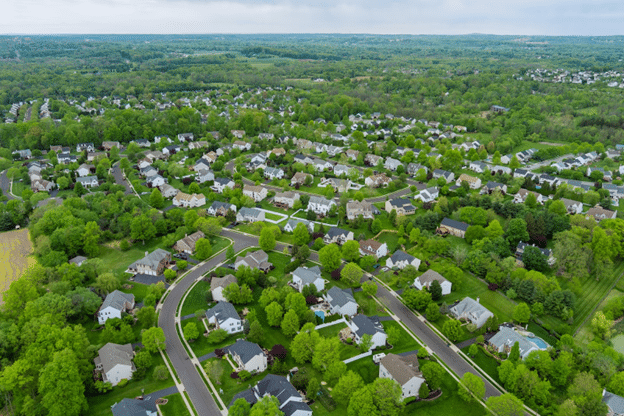
As the world grapples with the urgent need to combat climate change, it becomes increasingly crucial to explore innovative strategies for smart growth to reduce greenhouse gas emissions. While efforts like transitioning to renewable energy sources and improving public transportation are well-known solutions, there is an often-overlooked aspect that holds immense potential: rethinking spread-out neighborhoods. In this blog post, we will discuss how reconsidering the design and development of neighborhoods can significantly contribute to decreasing municipal emissions and creating more sustainable communities.
The Impact of Spread-Out Neighborhoods
Spread-out or low-density neighborhoods, with sprawling suburbs and large distances between homes, have become a feature of many cities. However, these types of neighborhoods contribute significantly to increased municipal emissions. The long commuting distances between homes, workplaces, and amenities lead to a heavy reliance on private vehicles. This results in higher fuel consumption and elevated carbon dioxide emissions.
Encouraging Smart Growth
One effective approach to decreasing municipal emissions is by promoting compact development. Compact development emphasizes creating neighborhoods with mixed land uses, where residential, commercial, and recreational areas are in close proximity. With compact development, residents can have easy access to essential amenities, reducing the need for long-distance travel.
Compact development can be achieved through various strategies, including:
a) Mixed-Use Zoning: Implementing zoning regulations that allow for a mix of residential, commercial, and recreational activities within the same neighborhood encourages residents to walk or bike to nearby destinations instead of driving.
b) Transit-Oriented Development: Designing neighborhoods around public transportation hubs encourages residents to utilize mass transit systems, reducing car dependency and subsequent emissions.
c) Pedestrian and Bicycle Infrastructure: Creating safe and well-connected pedestrian and bicycle networks promotes active modes of transportation, leading to reduced reliance on cars.
Implementing Smart Growth Principles
Smart growth principles can play a vital role in rethinking spread-out neighborhoods. Smart growth involves designing communities that are compact, walkable, and environmentally sustainable. By adhering to these principles, municipalities can mitigate the environmental impacts of urban sprawl and decrease emissions. Some key aspects of smart growth include:
a) Mixed-Income Housing: Building neighborhoods with a range of housing options that cater to different income levels promotes social equity and reduces the need for long commutes.
b) Green Spaces and Parks: Integrating green spaces and parks within neighborhoods provides recreational opportunities. Additionally, these spaces contribute to carbon sequestration and improve air quality.
c) Brownfield Redevelopment: Revitalizing underutilized or contaminated areas within existing neighborhoods reduces the need for expanding into undeveloped land, preserving natural resources.
Community Engagement and Participation
Engaging the community is crucial for successfully rethinking spread-out neighborhoods. Municipalities should actively involve residents in the planning and decision-making processes. Conducting public consultations, workshops, and surveys enables a collective vision for sustainable neighborhoods. This encourages a sense of ownership and commitment to the transformation.
Making a Difference – Smart Growth Now
Rethinking spread-out neighborhoods offers an opportunity for decreasing municipal emissions and building sustainable communities. By embracing compact development, implementing smart growth principles, and encouraging community participation, municipalities can significantly reduce car dependency. The result is a decrease in greenhouse gas emissions, improved air quality, enhanced livability, and a more resilient and environmentally conscious city.
As we collectively strive to combat climate change, it is essential to prioritize sustainable urban planning and design. By reimagining our neighborhoods, we can pave the way for a more sustainable future. Let’s embrace this opportunity to transform our cities into eco-friendly communities. The power to create change lies in our hands. Together, we can reshape our spread-out neighborhoods and create a greener, healthier world for generations to come. The EMAT energy auditing team has the experience, knowledge, and capabilities (and the EMAT software tool) to handle all of your energy audit needs. Check out the benefits of using EMAT Audit Services. To learn more, call now!